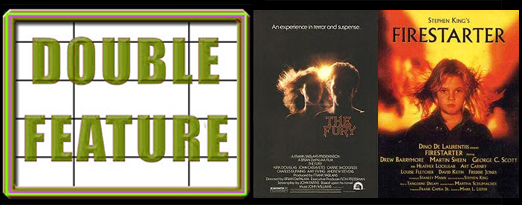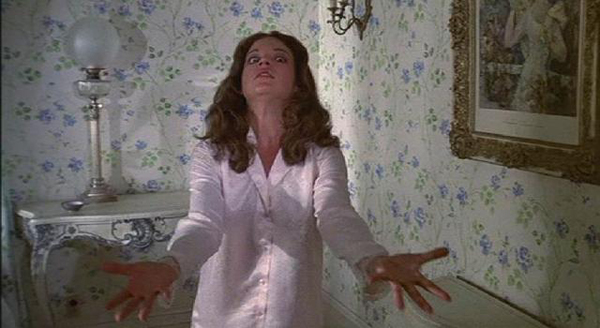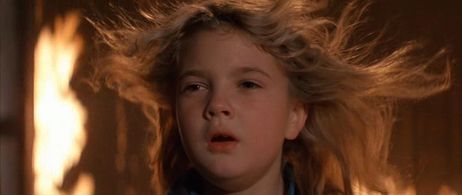
The double feature is cinema appreciation at its most basic. The mere act of pairing two films together – whether the bond be subject matter, central theme, a certain actor or filmmaker, or something outside-the-box conceptual – causes them to take on a different sort of life. A new relationship is formed with the viewer. You pay attention to new aspects and journey down unfamiliar avenues when you view films through Double Feature Goggles. Even when the linking bond is comically tenuous, the double feature magic is there. And I’m the kind of guy who derives just as much pleasure from creating a double feature as I do from watching one. Aside from amusing myself, hopefully I can give some people ideas for their next movie night.
The Double Feature: The Fury (1978) and Firestarter (1984).
The Connection: Young girls grappling with powerful and dangerous psychic/telekinetic powers. Evil clandestine government agencies out to control them. A desperate father trying to protect his child from said agency. Bizarrely all-star casts.
Film 1: After solidifying his career with the tale of a teenage girl discovering her fearsome mental powers in Carrie, director Brian De Palma oddly (or appropriately, depending on how you look at it) decided to dig a little deeper into the subject for his next outing. The Fury‘s storyline is kind of all over the place structurally, but at its core is fairly simple: Peter (Kirk Douglas) and Childress (John Cassavetes) work for a shadowy, never fully explained government organization. Peter’s son Robin (Andrew Stevens) has been displaying powerful psychic abilities. To gain total control over Robin, Childress tries to have Peter murdered. Robin thinks his father is dead, but really he’s gone into hiding. Years later, in an attempt to locate Robin, Peter has seduced an employee (Carrie Snodgress) at a school for psychic research. Entering this embroiled scenario is Gillian (ex-Mrs. Spielberg, Amy Irving), a wealthy private schooler who has begun to display dangerous powers. Now Peter wants Gillian to help him find his son, and Childress wants Gillian for the same reasons he wanted Robin.
The Fury is a weird movie, not so much in it concepts and characters, but simply in the way the story is told. Peter and Gillian are dual protagonists, which is both interesting at times and also narratively problematic – as we’ll often go long stretches without seeing one or the other. Then in the final third of the film, we’re given a third perspective to play with. The film is based on a book by John Farris (who also wrote the screenplay), and this is the exact sort of thing that works smoothly in a novel but awkwardly in a film. This serves to make the ending a bit clumsy and unemotional, and throughout the film you continually get the feeling that you’re not getting quite enough of any of the plotlines – in particular Robin’s. But oddly enough, the film’s greatest failing is also its most interesting attribute in some ways.
You really need to piece The Fury together yourself. And I don’t mean that in a Memento way. More of a Lost way. The film’s opening set-piece – featuring some great machine-gunning by Chin-Dimple Douglas – would probably get you an F in screenwriting class. If you watched this movie cold, with no prior knowledge of its subject matter, you’d become incredibly perplexed by the conversation Peter has with his son, in which we “learn” that Robin has psychic powers. But on the other hand, this gives the film a very naturalistic approach for such a high concept film. No one explains much of anything to anyone in the film. Things just happen, or are cryptically implied. If the story were a little more complex this would be a disaster, but as it is it kinda works in a wonky sort of way.
This is most prominently on display once we cross over to Robin’s storyline. We never actually learn what Childress wants Robin for. Though we’ve seen enough of these sorts of films to presume it is weapon/spy related. It is a little tragic that The Fury is at its most memorable during this final third of its run-time, when the most bonkers and intense of the psychic action takes place (Gillian’s powers are not very strong when compared with Robin’s). Especially from De Palma’s side, as it is only when the film gets truly nutso that it feels like the director becomes unbridled (aside from some obnoxious De Palma camera pans here and there earlier on). Though this hints at a maybe more fantastic movie that could’ve been, I think it makes the ending all the more effective, as it feels like the pay off to a slow burn. Plus, Andrew Stevens is kind of irritating as Robin, so really the less of him the better.
The real show here is Kirk Douglas and John Cassavetes. Douglas is far too old for his character, but he’s Kirk Douglas so who gives a shit. As this year’s Oscars proved, even at 90+ years of age and completely stroked out, the man is pure charisma. And weirdly his storyline features two lengthy comedy set-pieces. So Douglas is given a lot of broad stuff to do here in between all the shooting, shouting, and slapping of Amy Irving. Cassavetes, with his watery alcoholic eyes, is pure slime. And its fun to watch the man work, giving a surprisingly subtle performance for such an unsubtle movie. He’s also got one of the all-time great villain deaths here, in the film’s most perfect scene.
The entire cast is surprisingly noteworthy. Besides those already named, Charles Durning plays a pivotal role. The film also features a fun cameo by De Palma early-career fav William Finley, as well as brief appearances by a very young Daryl Hannah and a considerably more svelte and handsome Dennis Franz.
Pauline Kael really loved the score for the film by John Williams. So that seems worth mentioning, though I didn’t find anything particularly special about it considering the heights Williams reached elsewhere.

Film 2: De Palma wasn’t the only person who didn’t feel like they’d said all they had to say on psychic girls after Carrie. In 1980, Stephen King published Firestarter, upon which the film is based. The story follows a father and daughter, Andy (David Keith) and Charlie McGee (Drew Barrymore), two psychics on the run from a – you guessed it – shadowy government agency run by Captain Hollister (Martin Sheen). Andy has the power to “push” people, planting suggestions in their minds and bending their wills. Charlie has pyrokinesis, but is too young to properly control the power, often accidentally lighting fires when she’s upset. Hollister wants to harness Charlie’s power, which is slightly less dubious than the motivations of his side-kick, John Rainbird (George C. Scott), a stoic Native American who agrees to help trick Charlie into playing along with Hollister if he is allowed to have Charlie when the scientists are done… so he can kill her and absorb her mojo in the afterlife.
Like most of Mark L. Lester’s films (Class of 1984, Commando) this film is appealing in that slightly off early mid-80’s sort of way. It is ungainly and often slow paced, but never uninteresting. The chase portion of the film, when Andy and Charlie are trying to evade being caught, is probably the most entertaining, but it becomes more involving once they’re caught and Rainbird goes to work. If you can get past George C. Scott playing an Indian with a ponytail, it is a creepily engaging performance. It’s actually kind of bizarre to see Scott giving such a restrained performance, especially at this stage in his life when he’d become a glutton for awesome scenery chewing (what up, Excorcist III?). The character’s motivations are so weird, and the scenes between Rainbird and Hollister are the best parts of the film. Martin Sheen is also marvelous in a fairly blankly written role, playing Hollister with a bemused yet assertive cluelessness.
Drew Barrymore was definitely one of the best child actors movies ever had, as she was able to retain that believable level of little kid self-unawareness that usually disappears with kids able to give performances meaty enough to carry a film. And her wind-blown hair “firestarting” scenes are all great. There is an amazing scene when the evil agents have Andy and Charlie surrounded and Andy commands his daughter to freak the fuck out and kill them all. Not a moment you expect, and it seems to go on forever as Lester fetishizes the individual flaming of each agent and explosion of each car. It’s frankly rather comically belabored. But in the best kind of Mark. L. Lester way. Though the finale really shows that set piece up. One may wonder why Lester was offered Commando based on this film, but after the climax you’ll see why.
Like The Fury, this has a weirdly good cast for such a dorky genre movie. Along with Scott, it also features two other Oscar winners – Louise Fletcher and TV legend Art Carney. Plus Moses Gunn, Heather Locklear, and David Lynch regular Freddie Jones.

Double Feature Goggles: It is interesting how the tropes of the psychic thriller subgenre so immediately solidified. Scanners borrowed very heavily from The Fury, for one. But even just comparing our two films here – nose bleeds seem very crucial. In The Fury Amy Irving causes none-bleeds in others. In Firestarter David Keith gets nosebleeds himself when he “pushes” people. And its interesting to see how the two filmmakers choose to create the visual representation of our psychic girls’ powers. Lester employs the wind machine, and things sort of ramp down, as though the world were stopping to an effect, because we’re seeing the scenes from the perspective of Barrymore (who must concentrate on controlling her powers). De Palma gets hectic, with tense camera angles, loud score, and frantic editing, because Irving’s powers sneak up on her. They’re jarring. And though the two central girls are of differing ages, they’re both in the position of discovering their powers. So they feel quite similar.
I’m always amused by shadowy government agencies. The Fury has a classic improbable agency that feels like a super villain organization. Firestarter‘s group feels a bit more plausible, as we witness some of their bureaucratic woes and are given at least a little backstory on its origins. And in The Fury psychics simply exist naturally, whereas they were essentially created by the agency in Firestarter.
It’s also interesting how different giving David Keith psychic powers too changes the tone of Firestarter from The Fury. Large portions of The Fury play purely like a spy thriller, with Kirk Douglass sneaking out windows and putting on disguises. Firestarter on the other hand feels like a sci-fi film through and through. It has a more cohesive tone.
Previous Double Features
The Commitments/The Blues Brothers | The Set-Up/High Noon
The Plague Dogs/Secret of NIMH | The Old Dark House/Dolls